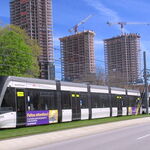nfitz
Superstar
VIA has previously talked about running Toronto to Montreal expresses through Ottawa but without stopping. So no deceleration and stopping.But the T-O and O-M routes add up to 5 minutes longer than the T-M, yet a stop in Ottawa would add at least 15 minutes due to deceleration and loading, so the time would have to be about 4:05, not 3:45.
Can VIA run on that CN track between Hunt Club and Walkley, to avoid Ottawa station? Or perhaps lay another track along there?




